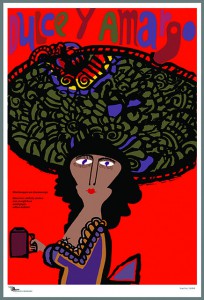Design and Cultural Identity
 Since the time I was a student I have had the curiosity to understand why our design looks so globalized, so similar to designs from other parts of the world. When I asked my teachers about that, they always responded: “That’s good because it makes us more competitive against other designers in the world”. At that age of immaturity, naivety and insecurity this information sounded logic enough for me and made me calmed me down.
Since the time I was a student I have had the curiosity to understand why our design looks so globalized, so similar to designs from other parts of the world. When I asked my teachers about that, they always responded: “That’s good because it makes us more competitive against other designers in the world”. At that age of immaturity, naivety and insecurity this information sounded logic enough for me and made me calmed me down.
As I advanced in my studies, the doubts reappeared… and the concern has continued since then.
Recently, I had the opportunity to lead a thesis project concerning the presence of modular design in ceremonial Mesoamerican pottery. Once again, the experience rekindled the feeling that we have mistaken the path to making a design that is not only functional but that represents us and defines us, at least, as Latin-Americans.
When talking about a Latin American identity we must, without a doubt, travel far back in time, to the event that made us in what we are now: “The Conquest”. When the Spaniards came, our native people were in most cases brutally reduced; those that went against the conquerors were exterminated and the rest of them were forced to adapt to transculturization, thus surrendering their beliefs, habits, religion, moral code, and relinquishing their cultural legacy. As a result, an incident appeared and changed our course, transforming us into a hybrid culture, into a mixed culture: miscegenation. This process, through which our ancestors disguised their ways and cultural expressions with a tint or nuance that guaranteed them some coexistence -not an equal one, but in any case a bearable one- with their conquerors, was a way to keep at least a small part of the hidden essence of their traditions and transfer it into this new way of life.
Nevertheless, this must not be used as an excuse to forget our origin but it should rather help us potentialize our historic memory and rescue the good from what both cultures gave us. “Not this or that. This and that”, as Bulgarian philosopher Tzvetan Todorov said.
This is the way in which countries are striving to rescue this cultural inheritance. Their governments provide their ethnic people with both, support and protection, regardless of how few still exist. They show them a sense of belonging and are respectful of their culture of origin, and this reflects upon all aspects of their creative and cultural production.
Such is the case of Mexico, a country that stands out for keeping a big part of its pre-colonial inheritance, one that comes through in the food, drinks, fabrics, jewelry, dance, music, as well as in Mexico’s graphic and artistic creation in general, which is enriched with this blend and has been modified and modernized with the passing of time. In the same status are Cuba, Colombia, Venezuela and Chile, remarkable examples of a well-defined cultural identity.
When we discuss identity we are not saying that we must directly use the designs extracted from the native codices or pottery and make a replica of their graphic style. Yet think. Meditate. Stop for a moment and find in them our sources of inspiration, as it was well said by the Catalonian architect Antonio Gaudí: “To be original is to go back to the origin.” We must go back to our origin and rescue the colors, the traces, the essence of our ancestors and merge it with the modern trends, remembering to use design theory and rules.
Lately, we have been bombarded with blogs, articles, books, campaigns and speeches about “good design” and “responsible* design” (accountable design?) but these are only focused on the environmental problem, setting aside the big responsibility we have as designers, as cultural creators towards the new generations.
We cannot leave this responsibility, the future of our visual culture and our design vision, in the hands of others. We must have in mind, and as a priority, to stand out as a part of a Latin America that is full of social, economic, and political contrasts; as a Latin America that is defiant and changing, that has been nourished by and adapted to foreign influences in different ways.
We must be aware that identity is built from our past, but with our gaze in our future, having a clear knowledge about where we come from, who we are and which are our strongest skills. In this way it will be easier to define and find the course towards where we are going, and to do it in our own way, letting our design be known and identified, setting us apart from the rest.
It is not enough to design well; besides that, we need do it with cultural accountability, being proud of our legacy and making sure that the design produced in our region has a place in history.
I close this first installment by quoting the Mexican philosopher Leopoldo Zea: “Let us be ourselves instead of imitating. We will be Latin America, without relinquishing what we are, but being us.”
Larisa Hernández
Coordinadora de Proyección Social y Docente de la ECMH. Diseñadora gráfica e ilustradora, exporta diseño a diferentes industrias en USA.

